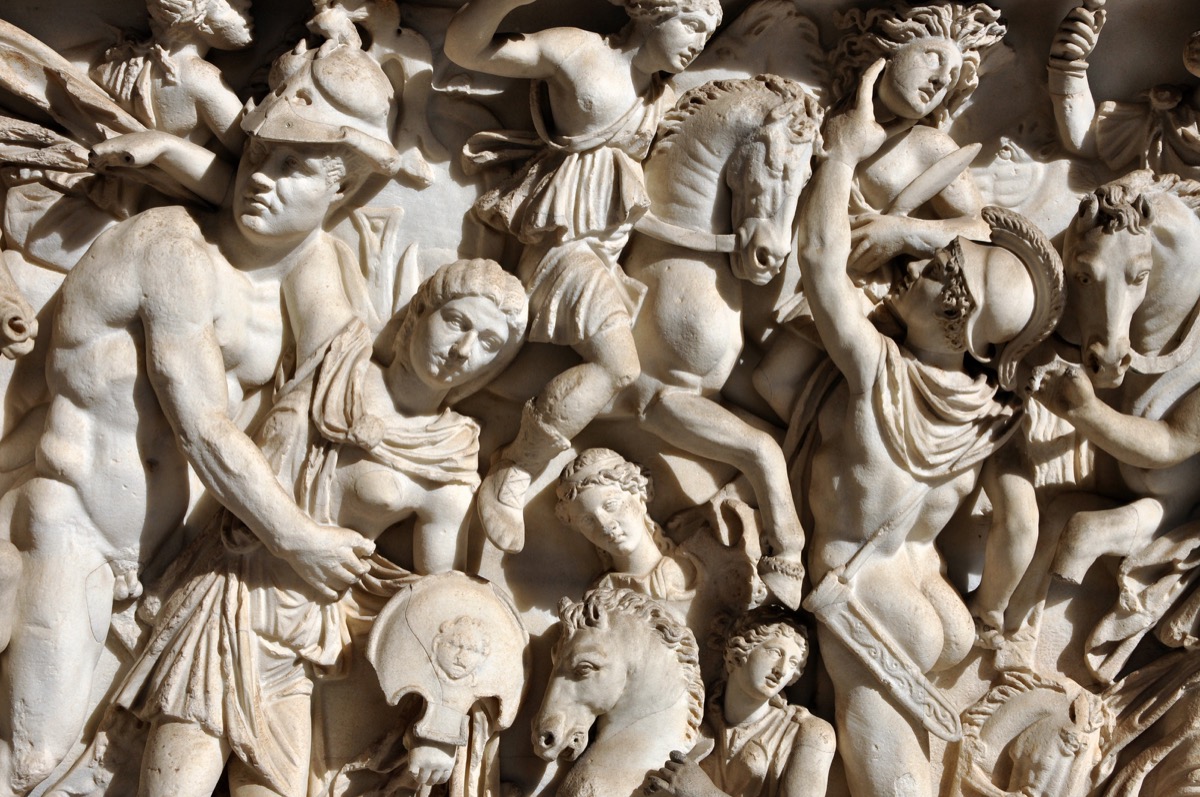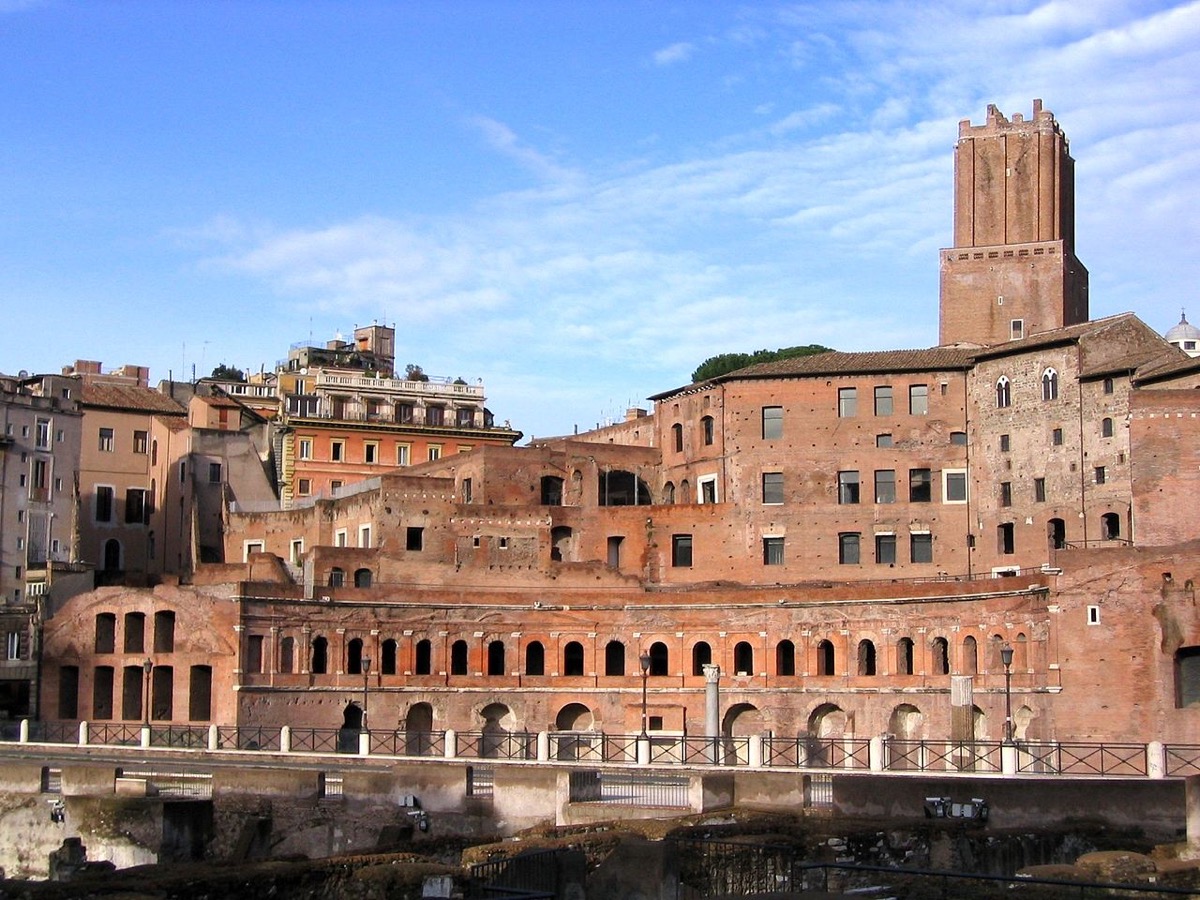27 Facts About Ancient Rome That Are Eerily Relevant Today

For more than a millennia, the Roman Empire dominated the earth. Of course, the exact time frame is up for debate, but, depending on which historian you ask, Roman rule dates as far back as circa 750 B.C.E. and ran up until somewhere in the latter half of the fifth century C.E. No matter how you cut it, that’s a staggeringly large chunk of human history.
With that in mind, it should be no surprise that the era of Julius Caesar and Marcus Aurelius has had a major, permeating effect on society as we know it. Here are all the ways that life in Ancient Rome is eerily relevant to life today.
1
Ancient Rome was more densely populated than modern Manhattan.

At 25,846 people per square-kilometer, Manhattan has the highest population density of any American locale. Even so, it pales to that of ancient Rome. Many experts estimate that, at the city’s peak, 1 million people lived within the Aurelian Walls—resulting in a population density of 72,150 per square-kilometer. Small wonder ancient Romans were the first people to live in apartments.
2
Rome’s Senate was hopelessly partisan.

Because the Roman republic practiced separation of power in its government, the Senate, whose name comes from the Roman “Senatus Populus Que Romanus” (SPQR), existed to oversee elections, legislation, criminal trials, and even foreign policy. But after the Roman republic defeated Carthage in the Punic Wars in 146 B.C.E., the Senators focused more and more on protecting their own self interests—and quickly developed into extremely polarized partisanship.
According to Jim Barron, a history and classics teacher at the Germantown Friends School, “The Senators were always under the impression that they were doing what was best for the republic” resulting in “doing something this way, or doing it that way. No compromise [could] be reached.”
3
Rome invented modern hydropower.

By the first century C.E., the Romans had already harnessed water power. Aqueducts and enormous waterwheels were often used to power mills that ground grain into flour, which was used to feed the masses. Despite the troves of knowledge, technology, and information that were lost following the fall of Rome, hydropower survived. That technology has morphed into the hydropower we know today, which is currently responsible for 71 percent of all renewable energy and 16.4 percent of energy overall worldwide.
4
Teens back then also skipped class to drink.

When it comes to raising children, modern parents face some of the same problems as ancient parents, especially since the trope of rebellious youth was present even in the Roman Age. Parents of wild teenagers will be able to relate to Cicero, whose son, Marcus, regularly skipped his university lectures to go out drinking and partying. From Rome’s chariot races to free-flowing wine, it’s easy to see how the young Marcus could be easily distracted.
5
Today’s sports stadiums are modeled after ancient Roman versions.

If you’ve ever been stuck in the nosebleed seats at Gillette Stadium, blame the Romans. According to a report in Sports Illustrated, stadiums and arenas today are largely influenced by the stadiums and arenas of Ancient Rome. (It should be noted, however, that the design of Roman stadiums was a bit derivative of the amphitheaters that populated the landscape of Ancient Greece.)
6
The world’s first shopping mall popped up in Ancient Rome.

You might think the shopping mall is a uniquely American innovation. (Just ask the 42 million annual visitors to the Mall of America, in Minneapolis.) But the world’s very first shopping mall dates back to the first century C.E. Trajan’s Market—named after Trajan, one of the so-called Five Good Emperors—featured more than 150 individual shops and offices.
7
Modern plumbing was pioneered by Roman engineers.

Someone would have invented it sooner or later, but in fact, it’s the Romans we have to thanks for indoor plumbing. Though they didn’t perfect it (toilets were usually in kitchens and lead pipes often caused lead poisoning), they were the first to install a network of pipes in the home. The pipes were used to move waste, but were also used to move water in the hotter months as a way to keep cool indoors. The Romans are also responsible for inventing the sewer system, though most indoor plumbing systems didn’t actually lead to the sewer.
8
Rome turned bread into a staple food.

When it comes to bread, the Romans were revolutionary beyond inventing the water-powered mill. They also popularized yeasted bread for the first time in history and even formed baker’s guilds that catered to wealthy citizens. High demands for white bread led to the invention of the first mechanical dough mixer. (Though, at the time, “mechanical” meant: powered by donkeys and horses.)
9
Traffic was a major headache in Ancient Rome.

You think your commute is bad? Traffic in Ancient Rome started at the a.m. rush hour…and carried all the way into the night. To take it from 1st-century scribe Decimus Iunius Iuvenalis—which means taking it with a massive grain of salt, as Iuvenalis was a well-known satirist—the traffic literally caused in multiple deaths, as a result of insomnia due to noise pollution. And you thought 295 was bad…
10
Ancient Rome had a robust food welfare program.

Long before American politicians on both sides of the aisle were arguing over health care and other government-subsidized commodities, the Romans were happily doling out portions of free grain to the city’s poorest citizens. The policy, called Cura Annonae, advanced as the empire grew, eventually offering these portions to citizens outside the city. By the 3rd century C.E., the empire was no longer just distributing grain, but bread, olive oil, wine, and even pork.
11
The Romans used an herb called silphium for contraception.

Silphium was an herb beloved by the Romans for its natural contraceptive properties. When consumed, it induced menstruation, and could—as legend has it—even force miscarriages in pregnant women. The herb was so popular that the Romans consumed it into extinction around the end of the 1st century.
12
Roman concrete is the strongest building material in history.

The Romans were master builders not just in terms of architecture, but also in terms of building materials, the most impressive of which was concrete. Unfortunately, the knowledge of the makeup of Roman concrete was lost during the fall of Rome. Though modern engineers have managed to create sturdy concrete, our mortar is still no match. Made with volcanic ash, Roman concrete was incredibly strong and reactive to other materials, making it resistant to weather and other naturally erosive agents. No wonder many of these concrete structures still stand millennia later.
13
Rome rose to power on the back of an expansive highway network.

One of Rome’s greatest accomplishments in the field is the vast network of roads that the empire built all across the Mediterranean. Made of laid gravel and large, flat stones, these roads covered over 50,000 miles and mostly served to connect conquered cities. Many of these roads lasted well into the Middle Ages, and fragments of them can even be seen today.
14
Latin, the official language of Rome, shaped language for a billion present-day people.

Carpe diem, alma mater, semper fi, e pluribus unum, et cetera—these are just a few of the phrases we’ve adopted from Latin, the native language of the Roman Empire. But Latin roots are far deeper than adopted phrases. The language laid the groundwork for an entire class of so-called “Romance” languages, including French, Italian, Spanish, Portuguese, and Romanian. All told, about a billion people speak Romance languages in either a primary or secondary capacity.
15
Crop rotation comes from Roman farmers.

As the Roman empire rapidly grew, the number of mouths to feed increased, so farmers had to be strategic about their crops. What they came up with is a system of crop rotation, one that most Western farmers still practice today. Roman farmers rotated three fields through three stages that were equally important to the success and yield of their crops: “food, feed, and fallow.” One field was used for growing, the next for feeding livestock, and the third would lay bare to regain nutrients.
16
Romans dabbled in hallucinogenic substances.

Recreational drugs have been around since the dawn of time—just ask the Romans! Reportedly, for fun, they’d eat a fish called Salema Porgy—also known, in today’s parlance, as the Sarpa Salpa—to intentionally get high. According to one report in Clinical Toxicology, ingesting the fish can result in severe hallucinations. (Oh, the extent scientists will go to for “research…”)
17
Roman soldiers received veteran’s benefits.

During elections, we often hear candidates promise to improve veteran care and benefits—but the reality is that veteran pensions and health care are highly stipulated, and often subpar. Roman veterans would recognize the struggle. Like modern politicians, Roman politicians often wrestled with the problem of pensioning legionnaires, those who had fought in the Roman legion. Ultimately, Caesar first established the pension system, offering soldiers a retirement plan worth 13 times a soldier’s salary for those who served at least 20 years.
18
Roman poets influenced Shakespeare.

Nearly everyone in the English-speaking world has read Shakespeare, whether it be for pleasure or because it was required reading in school. Ergo (that’s a Latin word, by the way), you’ve interacted with Roman literature. One of the bard’s greatest influences, after all, was the Roman poet Ovid. A Midsummer Night’s Dream, Antony and Cleopatra, and The Winter’s Tale are just a few of the stories Shakespeare based on Ovid’s fables. What’s more, Ovid, Horace, and Virgil were the three Roman poets at the center of the “Golden Age of Poetry,” whose works are still studied and read today.
19
Christianity spawned from a Roman province.

Initially a small religious sect in the Roman province of Judea, Christianity would eventually grow into the world’s most popular religion. Three centuries later, the emperor Constantine declared Christianity the official religion of the Roman Empire. Even after the fall of Rome, Christianity continued to spread.
20
MVP athletes were gazillionaires—and insanely popular, too.

Long before football fans were shelling out thousands of dollars for a seat at the Super Bowl, Romans filled stadiums—like the 250,000-seat Circus Maximus—to watch chariot racers. Some of the more popular stars were practically ancient-era versions of LeBron James, Tom Brady, and Derek Jeter…all put together! Just look at Gaius Appuleius Diocles, who was so beloved that he earned the modern equivalent of $15 billion.
21
Emperors would self-vaccinate…against poison!

The fact that the Romans would think to vaccinate themselves against poisons rather than diseases says a lot about the threats that Roman emperors faced at the time. Called “mithridatism,” after King Mithridates IV of Pontus, many believed that it was possible to build immunity against some of the most deadly poisons, like arsenic. It wasn’t until the 18th century that Edward Jenner thought to do that same thing with deadly diseases.
22
Financial fraud rampant among Roman politicians.

Modern-day democracy is often said to be based upon Athenian democracy, but there are plenty of parallels between it and Roman democracy, as well. Some of those parallels: the division of government branches, the idea of elected officials, and, wouldn’t you know it, crooked politicians. In fact, Marcus Tullius Cicero—the same politician who argued fiscal conservatism to the Roman heads of state—was known to have pocketed a minor fortune by setting aside portions of government money for himself.
23
An issue with money in politics corroded Romans’ faith in the democratic system.

Romans established a republic as a governing body, and included annual democratic elections that have served as rough models for modern democratic elections. But over time, these elections also suffered from the same kind of excessive spending that is hotly debated today. As Slate notes, “Vote-buying made sense for individual politicians at the same time as it undermined the elite as a whole,” but, “by the end, chronic election-buying had helped grind down all faith in republican government.”
24
Arguments over Roman land reforms mirror redistricting debates today.

Land reforms have never been simple—not now, and definitely not during Roman times, such as when the Tiberius Gracchus proposed land be distributed to plebeians as a way to grow the army. Reportedly, his proposal sparked a five-decade-long debate that resulted in approximately zero people getting exactly what they want. Sound familiar? If not, just Google “redistricting” or “gerrymandering.”
25
Romans removed leaders only to end up with worse leaders.

There’s one big lesson that can be taken from Caesar’s assassination: getting rid of a tyrant doesn’t get rid of tyranny. Following the assassination—which happened because of his heavy-handed tyrannical rule—came a parade of even worse tyrants. Caligula, Augustus, Tiberius, and Nero all followed Caesar—and all were more murderous, more eccentric, and more self-involved than Caesar ever was. And for more paradigm-shifting historical trivia, don’t miss these 30 Crazy Facts That Will Change Your View of History.
26
Rome was the first to establish equal power among all citizens, regardless of class

The plebian tribunes were a huge advance for the lower class of the Roman Republic. Once they had their seat in the government, the plebeians exerted their power in the form of secession. Not unlike the concept of a government shutdown, plebian secessions involved the plebeian class, that is, the working class, leaving the city and the patricians to fend for themselves. This move was a successful form of negotiating and balancing the power and needs of all the Republic’s citizens, both rich and poor. Eventually, Hortensian Law was put in place, officially declaring plebeians and patricians equal under the eye of the law.
27
Vestiges of Roman architecture are still prevalent today, not least of which is the Roman arch

One of the most visible ways Rome has remained relevant in the modern day is in its lasting impact on architecture. No architectural innovation was so impactful as the arch. While the arch was not a new concept, the Roman arch utilized a keystone, which was larger and heavier than other stones that balanced supporting stones when placed in the center. The result was an arch more durable and effective even in large-scale architecture than ever before. Many still exist today, notably in the Roman aqueducts that remain across Mediterranean Europe.
To discover more amazing secrets about living your best life, click here to follow us on Instagram!